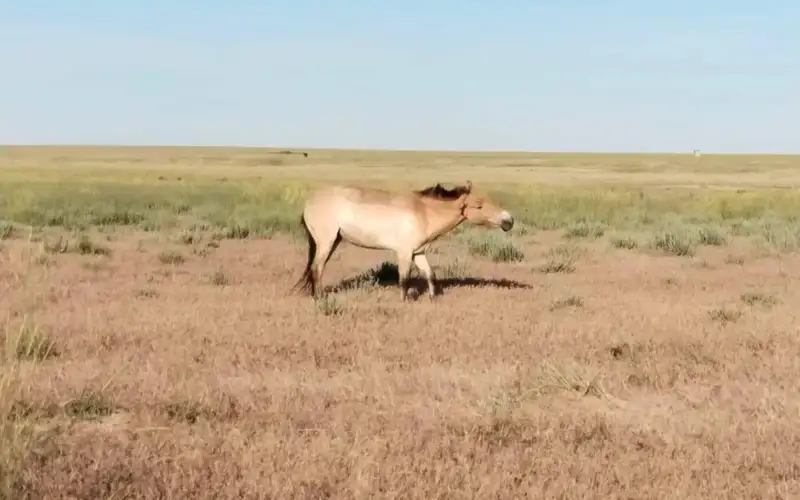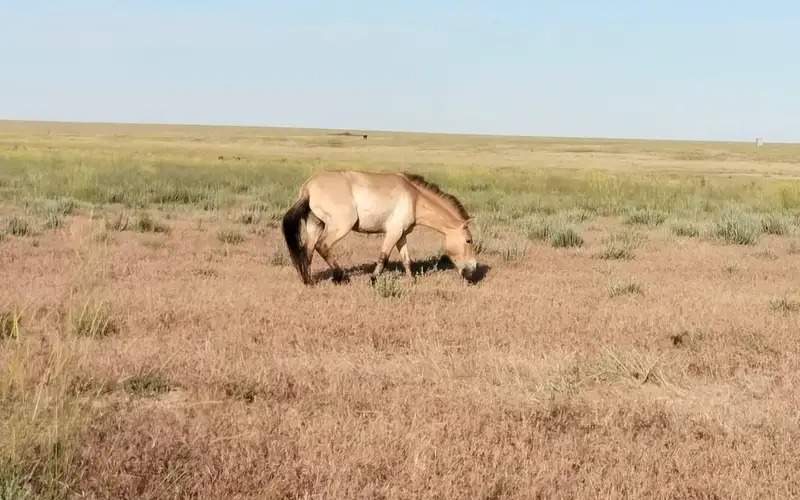Przewalski's horse - how Kerkulan adapts to the Kostanay region
The reintroduction of the Przewalski's horse has started in Kazakhstan. The project aims to relocate about 40 horses from Europe to Kazakhstan within five years, establishing the groundwork for the reintroduced population and recreation of the original functional steppe ecosystems, Kazinform News Agency correspondent reports.

The corresponding memorandum was signed back in April last year between the Forestry and Wildlife Committee of the Ministry of Ecology and Natural Resources and the Prague Zoo during the visit of Prime Minister of the Czech Republic Petr Fiala to Astana.
Currently, Przewalski's horses are available in zoos in Kazakhstan. There are about seven of them in total, they are located in the Almaty, Shymkent and Karaganda zoos.
The territory of the Altyn Dala state natural reserve in the Kostanay region, which was created in 2012, was chosen as the site for the reintroduction of wild horses.
A correspondent of the Kazinform News Agency spoke with specialists from the department of wildlife and hunting management of the RSU “Kostanay regional territorial inspection of forestry and wildlife” about the condition of horses and plans in general.
As Rustam Bidibaev, chief specialist of the department of wildlife and hunting management, says that the animals endured the flight well. The horses have already arrived in the town of Arkalyk. At the moment they are in the corral, where they are undergoing adaptation. The horses are in excellent condition.
Kazakh name of horse
Earlier, at a meeting organized by the committee of forestry and wildlife of the Ministry of ecology and natural resources of the Republic of Kazakhstan, it was decided to make changes to the relevant documents with the Kazakh name “Przhevalsky’s Horse” - “Kerkulan”, separated by commas - “Kertagy”.
Return to historical homeland
The species of Przewalski's horse (Equus przewalskii Poljakov, 1881 - editor's note) was found in 1879 in Dzungaria - a remote region of Mongolia and China - by the traveler Nikolai Mikhailovich Przhevalsky and described in 1881 by the curator of the mammal department of the Zoological Museum, Master of Zoology Ivan Polyakov. For some time it was considered the ancestor of the domestic horse, but genetic studies have shown this to be incorrect. The Przewalski's horse has 66 chromosomes in its cells, while domestic horses have 64.

The Przewalski's horse is listed as threatened on the IUCN Red List and on Appendix I of the Convention on International Trade in Endangered Species of Wild Fauna and Flora (CITES). The last habitat was Mongolia (they were found there until 1970). Now the animals are bred in zoos and nurseries, breeding centers and reintroduced in a number of areas in several countries.
According to the International Studbook, the current population of the species is more than 1,500 individuals, the annual population growth is estimated at 10-12%.
In the past, the species lived on the territory of the Asian steppes from Kazakhstan to the foothills of the Tien Shan and Mongolian Altai, and also occupied a significant part of the territory of present-day Kazakhstan, being one of the subspecies of the then widespread wild horse.
Among the reasons for the disappearance of the Przewalski's horse are shooting in the 1940s, harsh winters and economic use of pastures and watering places. But experts say the main reason is the human factor. People simply began to move the species out of the steppes into the desert. For this reason, for example, in Kazakhstan, wild horses disappeared for a whole century - earlier than the kulans.
To preserve the species, horses began to be caught to supply them to zoos in Europe. More than half of the animals captured died en route, so zoos soon began buying horses born in captivity: it was much cheaper than sending agents to Mongolia and paying for transportation. In total, from 1899 to 1903, 52 purebred Przewalski horses and 2 hybrids with domestic horses were exported from Mongolia to Europe.
As a result, about a hundred foals were produced, but the reproduction of wild horses began to fade by the end of the 30s of the last century and almost all horses kept in captivity became extinct. The causes of death were the unsuitability of the conditions of city zoos for free horses, the discrepancy between the commercial objectives of zoos and the goals of preserving the diversity of the gene pool of horses.The horses from which the modern stock came were preserved only in the Prague (Czech Republic) and Gellabrunovsky (Germany) zoos.
Features of Przewalski's horse
According to its characteristics, the Przewalski horse is quite strong, although it is small in stature. They calmly tolerate temperature changes: frosts down to -30°...-50° C, heat over 50° C, rain, storms. The “highlight” is the presence along the lower edge of the jaws of light, sparse hair, forming the so-called “whiskers”. They are especially obvious in winter and reach a length of 10 cm. Both males and females have whiskers.
Which horses are selected for reintroduction?
Several important criteria were taken into account when selecting horses. First of all, this means good health, fully vaccinated and well-fed in body type. External signs: the presence of those characteristic of a horse - a short standing mane without bangs, a tail covered with short hair at the top and long at the bottom, the presence of chestnuts on the front legs, the color is predominantly dun or bay dun, the presence of a “belt” along the back , there may be dark shoulder spots (“wings”), the color of the carpal and hock joints is black or light gray with zembroidity. For reintroduction, horses of both light and dark color varieties should be used.
Future plans
It was noted that with sufficient funding, successful progress of work and without cases of mass death of horses (jute, etc.), by 2029 the population could reach 150-200 horses. This will be enough for sufficient stability of the groups and further development of the program without the use of importing horses from abroad, which will significantly reduce the cost of work.
